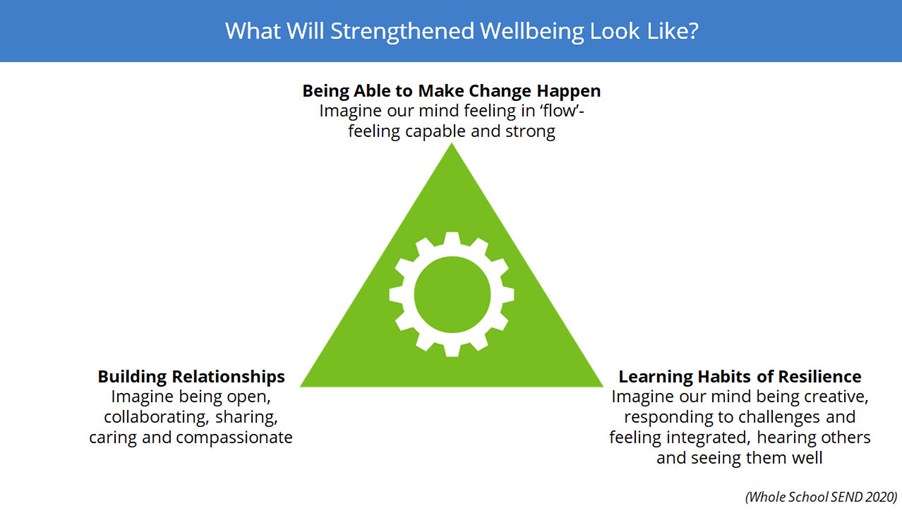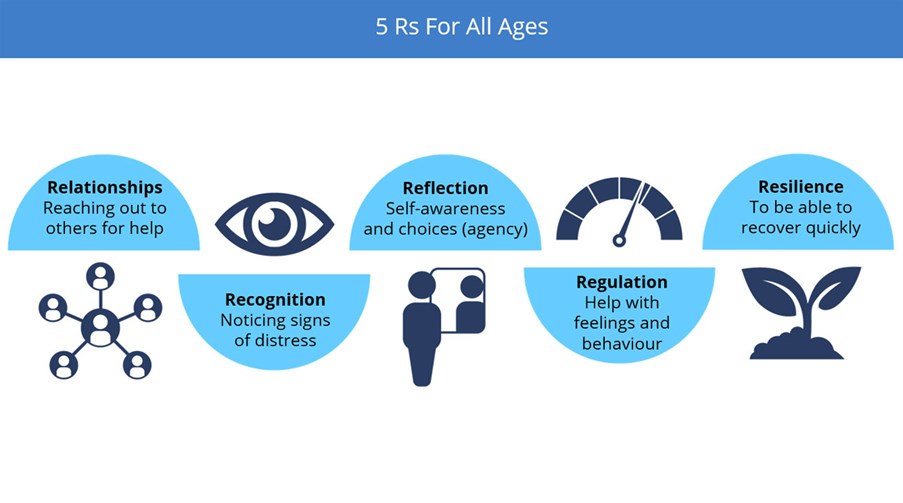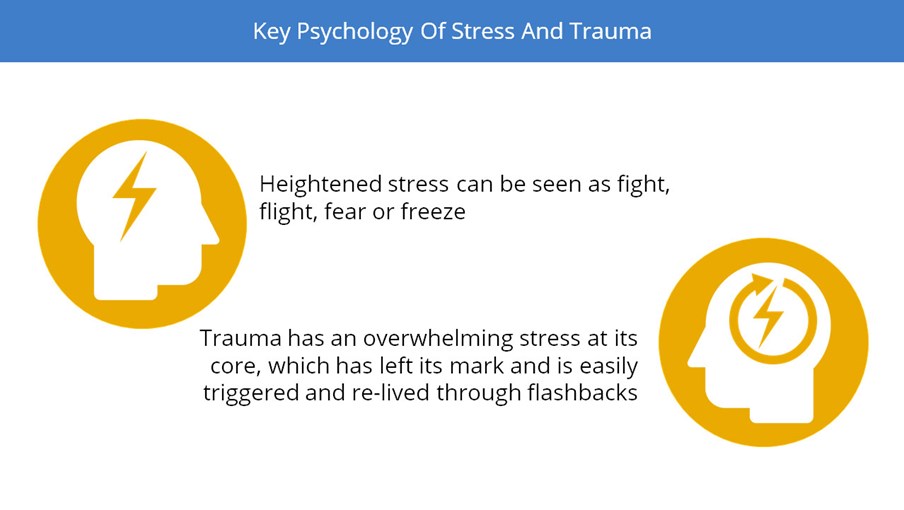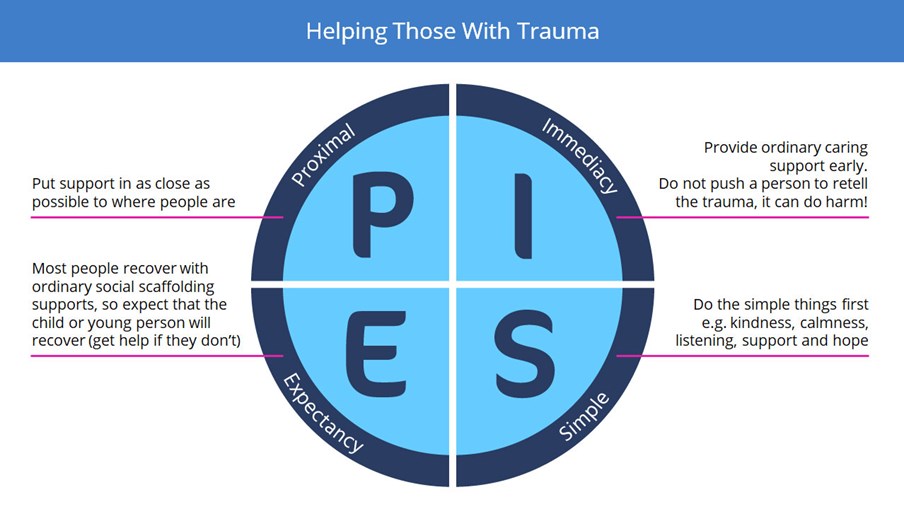Stress and Trauma - Bite size advice for Supporting Children and Young People
Stress is a normal part of life. The pandemic brings new and different challenges.
Remember, simple things can make huge differences.

Friendships are critical to us all: active listening
- Listen carefully, tuning in to each other really matters
- Simple acts of kindness may be all that is needed
- Be curious. Reflect and acknowledge thoughts and feelings
- Think about what you are able to do and what can be left undone
- Sometimes just being heard is enough
- Remember containment – holding another person’s (child’s) anxiety in mind and still having thinking space yourself. It can act like a ‘reboot’ or a ‘refresh’ psychologically
- Mend friendships by remembering to apologise. Adults need to model this!
Trust is key
- Loss of trust can leave people feeling overwhelmed
- Be honest and have integrity. Establish consistency to build trust with children, young people and families
- Teachers and professionals deliver a message through how they speak as well as what they say
If a child or young person wants to tell you about a trauma
- There is no one-off solution that will solve stress or trauma reactions
- Accept and validate thoughts and feelings
- Avoid pointed questions that cause re-living of traumas. It is ok to focus on what is happening now, what has become difficult and what has helped in the past
- Sometimes trying to forget and move on is exactly right
- Children might want to talk about what has happened
- They may express it through play, art, writing etc. to make sense of what happened
- We are all different in terms of how, when and where we recollect and process events
Building of confidence opens doors: stress and trauma closes doors
- Trauma may decrease confidence or make a person become reckless in trying new things out. In schools, this jeopardises learning. Think about how this will apply in your setting
- We cannot ignore what has happened in our communities. Reflective assemblies, tutorial sessions, commemorating the past and people, explaining through social stories will all support making meaning
- Making meaning matters for staff, pupils, and families alike. Reflect on both the positives and the negatives
- Remember, a child may need opportunities to talk privately beyond community events
- In schools/colleges, rebuild confidence by gradually building up to the attainment you 'know' a pupil is capable of
- Give pupils some control over tasks by RAG rating the tasks using red, amber and green cards, for example

Foster hope - it helps us cope!
- A belief that “I can” is psychologically protective. It builds resilience. Even small steps help
- Focus children on the tasks they have in front of them. Support them to succeed and build on their successes
- Tailor activities to individual interests, strengths and abilities
Stress and trauma can be contagious
- Our own stress/trauma reactions have an effect on other people. Therefore, everyone working with children, young people and families need to look after themselves
- Do the things that you know keep you healthy, calm and able to reflect on thoughts and feelings
- Support each other more than ever, offer a kind word and a listening ear
“Warning Signs” of who might need additional support
Most people exposed to psychological trauma do not develop mental disorder.
Take action if you see persistence, over days and weeks, or repeated episodes of:
- Social withdrawal, excessive sadness, tearfulness
- Great anxiety on separation from a parent
- Self-harm and suicidal thoughts or actions
- Unusual risky behaviours
- Sudden anger / rages
- Waking up with nightmares, difficulty sleeping (may be very tired in class)
- Repeated flashbacks, getting panicky
- Challenging behaviour e.g. aggression
Sometimes exposure to continuing stress can lead to trauma
- "Watchful waiting" and collecting observations will help determine whether these children and young people require more specialised therapies
- This should not be an excuse to avoid intervening. Most children are able to talk about what happened and how they felt, and are open to learning simple techniques to help to cope with their reactions
Simple things to do:
- Suggest they try to focus on what is going on around them and to let go of the panicky thoughts
- Address or test negative expectations
- Address uncertainty where you can
- Promote a sense of control
- Support manageable steps to overcome fears
- Support young people to get active, "have a go", and put fears to the test rather than overthinking
- Check in again on their anxiety levels (useful to self-rate 0 to 10) and use these to help them reflect on what has made a difference
- Look for signs of children and young people not coping
Keep all of the support in place and don’t step back. Be there for them, listen and support consistently. It will help, even if additional support is required.
Remember the children and young people with additional vulnerability. Monitor them more closely (not an exhaustive list)
- For BAME children and young people there have been a whole new set of fears set against longstanding unfairness and prejudice
- Be careful to be fair. It is not just what you do but how your actions are experienced by others that counts
- Children and young people in homes with domestic violence, or others at risk of abuse or neglect
- Looked after children and / or those in care
- Living in poverty, workless households, poor housing
- Those involved in or impacted by serious youth violence and / or gangs
- Those with adverse childhood experiences (ACEs), such as parental mental illnesses, drug or alcohol misuse
- Children with disabilities, autism or long term health conditions
- LGBTQ+ people
- Young carers
Teach and support children and young people to self-regulate
- Use interventions that help children and young people regulate themselves and feel safe, such as breathing techniques, sensory awareness, mindfulness and drawing exercises
- In schools, make sure your classrooms support self-regulation. Noisy spaces might make pupils relive their experiences. Adapt according to setting
- Suggest trying to make a small ‘resilience’ box with reminders of pleasant non-stressful memories triggered by all of the five senses; visual images, something to touch, smell, listen to and taste
- Provide access to quieter, safer spaces and adults with time to talk
- Be aware of those young people who may need additional support
- Remember that minor incidents that may go unnoticed by adults such as shouting or pushing might trigger distressing, vivid memories for some young people
Play-creative-physical activity: natural ways of managing stress and trauma reactions for all ages
- Create opportunities and spaces where children can play / create / exercise safely
- Allow pupils time to imagine, reflect, express, let-go, create, laugh, cry, have fun. Remind yourself and their parents too!
Children and young people are more resilient when adults work together
- This means adults in their family, school, and other agencies working together to deliver care and support. Create a "Team" around the child
- Your organisation could keep a register of pupils who have experienced stressful life events during the pandemic. Help everyone work together better
The following graphics provide some helpful summaries of ways to support each other and the psychology of stress and trauma




Further Resources
For Professionals
MindEd
Many e-learning topics for professionals who work with children and young people
Wellbeing for Education Return - MindEd webinar 2
In particular section 5
Wellbeing for Education Return
2 webinars with rich information
MindEd - Flashbacks, Trauma, Bullying
MindEd - Complex trauma and post-traumatic stress disorder
MindEd - Victims including domestic abuse
MindEd - Domestic abuse (more advanced material)
MindEd - Adverse Childhood Experiences (ACEs) programme
Including Knowledge and Skills Sessions
NHS Penine Care - Manchester Resilience Hub
Anna Freud National Centre for Children and Families - Youth Wellbeing Directory
Place 2 Be
Works mainly with Primary Schools
NSPCC resource on Social isolation and the risk of child maltreatment, in lockdown and beyond
Covid Trauma Response Working Group
For young people under stress
NHS - What to do if you're a young person and it's all getting too much
For students under stress
NHS - What to do if you're a student and it's all getting too much
Public Health England - No child left behind: Understanding and quantifying vulnerability
Next
Disclaimer
This document provides general information and discussions about health and related subjects. The information and other content provided in this document, or in any linked materials, are not intended and should not be construed as medical advice, nor is the information a substitute for professional medical expertise or treatment.
If you or any other person has a medical concern, you should consult with your healthcare provider or seek other professional medical treatment. Never disregard professional medical advice or delay in seeking it because of something that you have read in this document or in any linked materials. If you think you may have an emergency, call an appropriate source of help and support such as your doctor or emergency services immediately.
MindEd is created by a group of organisations and is funded by NHS England, the Department of Health and Social Care and the Department for Education.
© 2023 NHS England, MindEd Programme



